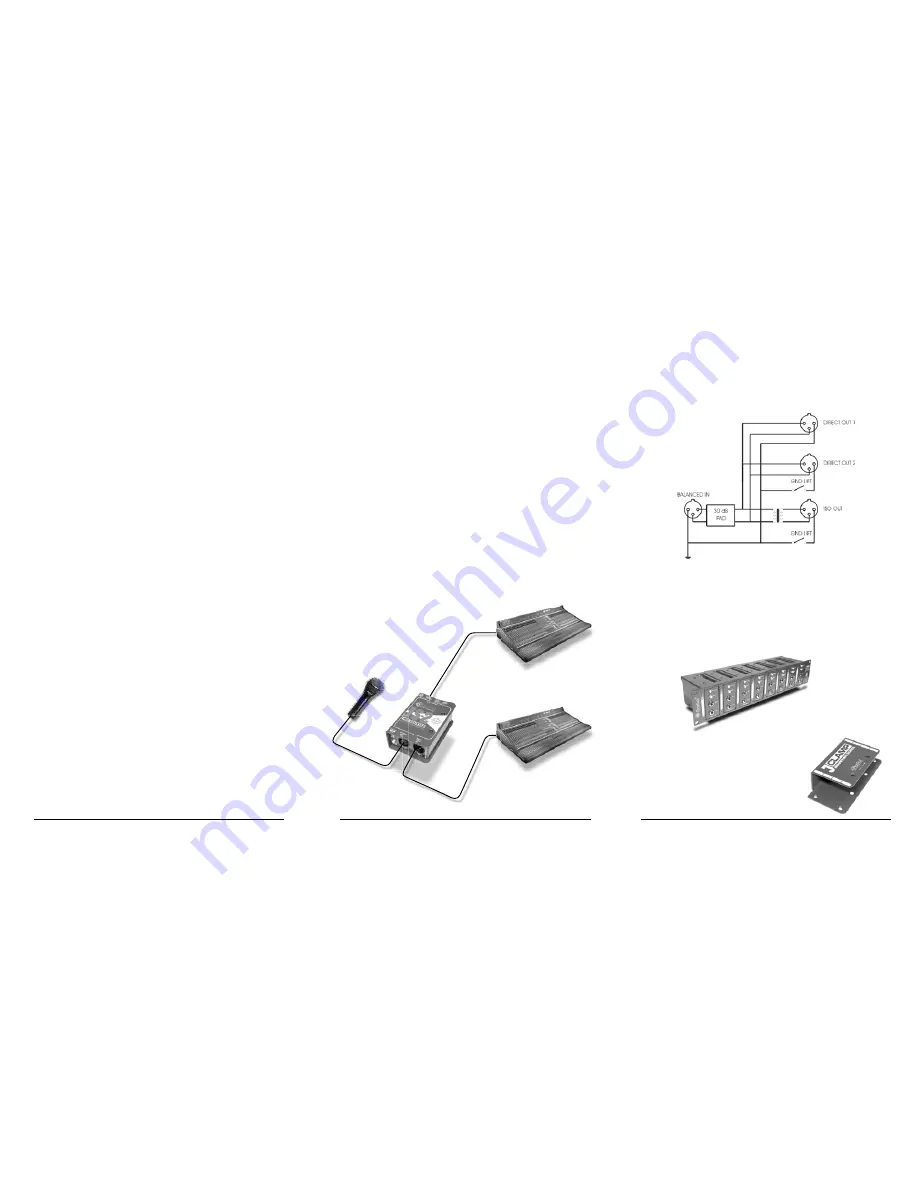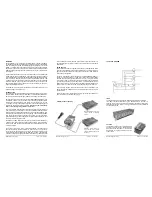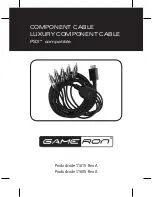
J-RAK
The optional J-RAK is a high density rackshelf for Radial DI’s and splitters.
It’s a 2RU rack chassis that allows up to 8 Radial devices in one neat 19”
package. The DI’s can be mounted with either the input side or output side
facing the front. Ideal for studio or touring. Constructed of 14 gauge steel with
a baked enamel fi nish.
J-CLAMP
The optional J-CLAMP can mount a single Radial
device to virtually any surface. Perfect for hiding
away inside racks, on podiums or under tables.
Constructed of 14 gauge steel with a baked
enamel fi nish.
JS•2 BLOCK DIAGRAM
DIRECT-1 output connects to
main console. This console
supplies phantom power back
to the mic.
ISOLATED output connects to
second console or recording
device.
2-Way Microphone Splitting
WELCOME
Congratulations on your purchase of the Radial JS•2 mic splitter. This simple
yet extremely handy device will likely fi nd its way into all types of applications
such as splitting mic signals and distributing signals throughout your sound
system. The Radial JS•2 is equipped with the world’s fi nest Jensen bridging
transformer to ensure the audio signal is transferred and distributed without
distortion and is built using the fi nest materials to ensure years of trouble-free
performance.
We have purposely written this manual to be short, as most users will likely be
familiar with the JS•2’s applications. We do suggest that you take a moment
to read through this document to familiarize yourself with the features that are
built in. For more detailed information, please visit the Radial website. This
is also where we post questions and answers that come from users after the
product is released. If you do not fi nd an answer, we invite you to send us an
email at [email protected] and we will do our best to answer your query in a
prompt and professional manner.
The Radial JS•2 is a wonderful device that will surely provide you with years of
problem-solving connectivity. Enjoy!
INTRODUCTION
Upon inspection, you will notice the Radial JS•2 is equipped with four XLR con-
nectors: the MIC INPUT connector; the DIRECT-1 THRU; the ISOLATED OUT-
PUT with ground lift switch and the DIRECT-2 THRU with ground lift switch.
Normally, the source microphone connects to the MICROPHONE INPUT and
the DIRECT-1 THRU connects to the mixing console that supplies phantom
power back to the microphone. If the source is a line-level device, such as
a CD player, the input pad should be engaged to ensure the signal does not
saturate the transformer, causing distortion.
Note that the JS•2 will always
output a mic-level signal regardless of input level.
The JS•2’s isolated output will then feed a tape recorder, broadcast truck or
other PA system. The advantage of using the transformer-isolated output is
that it creates a magnetic bridge between the source and the destination, thus
eliminating any direct electrical current from passing. This eliminates problems
such as ground loops which can cause buzz and hum in a sound system. A
ground lift switch is provided to disconnect the ground path between the input
and output to further suppress noise.
The DIRECT-2 THRU output is a direct output and is identical to the DIRECT-
1 THRU output, except that it is equipped with a separate ground lift switch.
This would be used to send a mic-level signal to an alternate device such as
a recording system.
The beauty of the JS•2 is that it is completely passive. This means that it
does not require any power whatsoever to make it work. The magic lies in
the quality of the transformer we use. Jensen transformers are famous for
their exceptional signal handling and low distortion. The JS•2 is equipped with
a Jensen JT-MBC mic-bridging transformer that features a laminated nickel
core and Faraday shield for optimum signal transfer. You will fi nd the JS•2 to
be transparent and very effi cient, making it the perfect choice in professional
installations.
USING THE JS•2
As with all Radial products, using the JS•2 is simple and straight ahead. Make
sure the sound system is turned off and all levels are set to zero before mak-
ing audio connections. This will avoid any pops in the sound system that could
cause damage to speakers.
Connect a microphone or line-level source to the MICROPHONE INPUT on
the JS•2. Connect the DIRECT-1 THRU output to the console that supplies
phantom power and then the ISOLATED OUTPUT to your monitor console
or recording system. If you plan to connect a main and monitor console AND
you want to also connect to a recording system, we recommend that the iso-
lated output go to the recorder and the monitor desk connect to the DIRECT-2
THRU output. If you encounter noise, simply depress the ground lift switch.
If you are using the JS•2 with a line-level device such as a keyboard or CD
player, depress the -30dB input pad. This will reduce the current going into
the transformer.
Start by turning up your sound system slowly to test connections before driv-
ing at full volume. You are now ready to go!
JS•2 User Guide
Radial Engineering
JS•2 User Guide
Radial Engineering
JS•2 User Guide
Radial Engineering




















